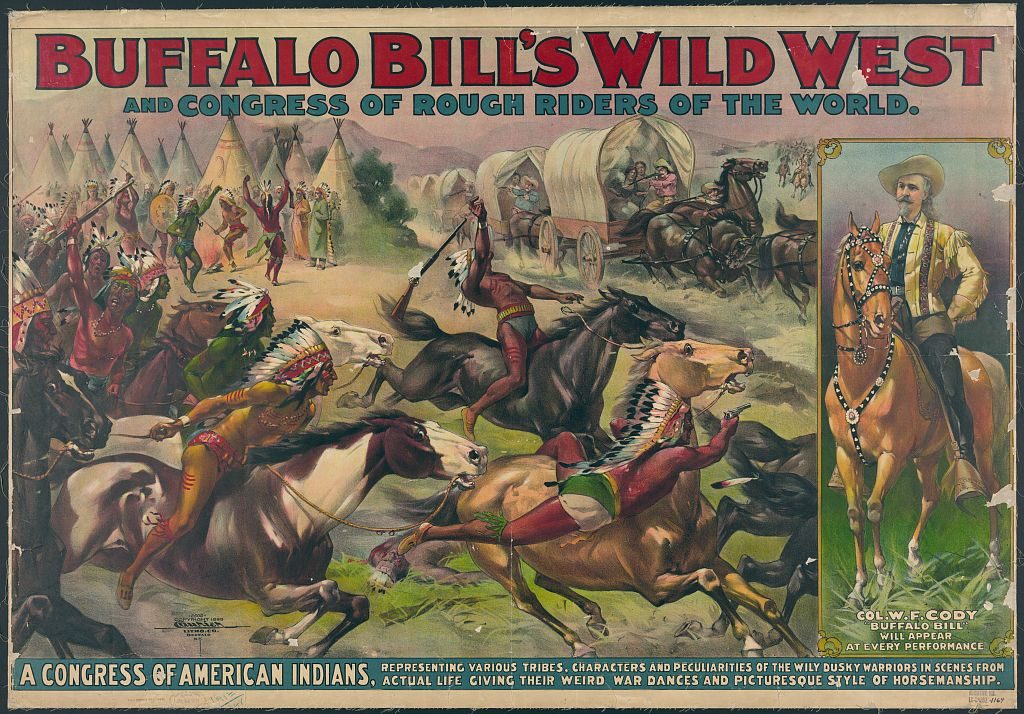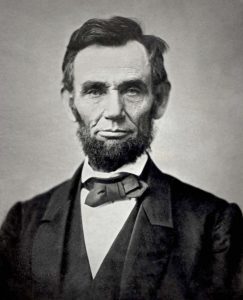In 1883, William “Buffalo Bill” Cody, famous frontiersman, army scout, and buffalo hunter, opened the doors of his Wild West Show for the first time.1 This show was a fantastical, exaggerated portrayal of life on the frontier, complete with reenactments of famous frontier battles with natives, displays by gifted marksmen (and one woman) and horsemen, and shows of the culture of the various Native Americans in Bill’s employ. This show would capture the hearts and minds of many people in the United States, and later on even in Europe, as Buffalo Bill’s show traveled to many European countries between 1886 and 1906.2

One of the reasons for the success of Buffalo Bill’s show was its “authenticity.” Bill himself was already somewhat of a celebrity in the west, after having earned his moniker “Buffalo Bill” for killing some 4,280 buffalo for the Kansas Pacific Railroad Company in the 1860s.3 Bill also had the good business sense to employ many of the Lakota Sioux and other Native Americans, including the man famous for the role he actually played at the Battle of the Little Big Horn, Chief Sitting Bull. It was in its depiction of Native Americans that many of his fans were drawn, enamored by the elaborate songs and dances of these peoples, with Buffalo Bill going so far as to say, “My Indians are the principal feature of this show.”4 The depiction of the Native Americans in his show was largely of their warrior culture, war regalia, and dances made for going into battle; however, this was taking place during the closing of the American frontier, when the death of the buffalo herds and the end of the Sioux Wars had largely ended this way of life in the west.
After roughly four months working with Cody, Sitting Bull grew tired of the show and left to return to the Standing Rock Reservation, where he would eventually be killed. Later in 1890, the Massacre at Wounded Knee would take place and many Sioux would be killed by the U.S. 7th Cavalry, the same regiment that fought with Custer years prior, at the Battle of the Little Big Horn.5 With this, the way of life that was shown in Buffalo Bill’s show was all but destroyed.

Even with this, Buffalo Bill’s Wild West Show continued to be popular up until it went bankrupt and closed in 1916.6 By 1916, the “Wild West” had not truly existed for quite some time; the country had been rapidly industrializing, and the age of both Cowboys and Indians would soon give way to the machine guns and artillery of the First World War. However, it was not the death of the west that ended Bill’s show, but rather the end of interest in the west. Although people praised Bill’s show for its authenticity, it was not authentic to the contemporary west. The show did not feature miles-long slow rides in freezing temperatures on cattle drives, and it did not show subsistence farming. What Buffalo Bill’s Wild West Show gave its audience was the same thing that they grew accustomed to from dime novels and stories of the west: rough and tumble cowboys, crack shots, skilled horsemen, and the Natives that made the west so dangerous. With the closing of the frontier and the nation looking outside of its borders to expand, the west was no longer as exotic as it once was in the public’s eye, and was anything but wild.
- Stephen G. Hyslop, “How the West was Spun,” American History 43, no. 4 (October 2008): 26. ↵
- Irene Lottini, “When Buffalo Bill crossed the ocean: Native American scenes in early twentieth century European culture,” European Journal Of American Culture 31, no. 3 (October 18, 2012): 187. ↵
- Stephen G. Hyslop, “How the West was Spun,” American History 43, no. 4 (October 2008): 27. ↵
- Stephen G. Hyslop, “How the West was Spun,” American History 43, no. 4 (October 2008): 33. ↵
- Stephen G. Hyslop, “How the West was Spun,” American History 43, no. 4 (October 2008): 33. ↵
- Douglas Seefeldt, “Buffalo Bill’s Wild West,” in America in the World, 1776 to the Present: A Supplement to the Dictionary of American History, edited by Edward J. Blum, Vol. 1. (Farmington Hills, MI: Charles Scribner’s Sons, 2016), 163. ↵



63 comments
Seth Roen
My Grandfather got to see Buffalo Bill’s last show before his show closed; due to it going bankrupt, and he retired from the stage light. But I could imagine watching a dramatized vision of the west before it was tamed. It is funny how we enjoy trying possible some of the worst conditions imaginable and the cruelty and humiliations of the Indian Nations of the Great Plains.
Amelie Rivas-Berlanga
Great article! It was very clear and easy to read. It explains the reason the show was a hit and what made it so memorable. The details that describe the show, and the things that made it unique tie the article together. The show including Native Americans and showing their culture is so cool! It was something that made this show unique.
Veronica Renee Lopez
I really enjoyed this article, I’ve always been interested in the “Wild West” era. This article is a good article for those who are interested in learning about the Westward Expansion. It may also be helpful when you’re doing research on a specific native group (the Sioux.) This article was very helpful to me and can be helpful to other students who are learning about Westward Expansion. I learned things that I didn’t know before.
Anissa Navarro
This article had displayed how the show was viewed, mentioning what the attributed to the show such as the chief, and the other Native Americans and of course Buffalo Bill. Taking the show over the seas to Europe had showed the Euopeans how the west of America had looked, although I do not think the show was accurate and I believe the show had mostly romanticized the west rather than displaying the truths, those who could not experience the west had much appreciated the show. Your description of the show had perfectly shown how the west was romanticized, and how there were many wrongs that went with it.
Dylan Miller
This article was a fun and interesting read. Personally, I liked that real authentic pictures of posters, maps, and a photo of Buffalo Bill himself really helps me put into perspective the success and popularity of the show! Not only did the pictures keep me interesting about the history of the show, but the story told of it’s succession and downfall was extremely interesting, and the author’s narrative skills and level of progression in the story let’s you hook you in, but also makes it comprehensible for any reader with little knowledge of the west’s history to understand the whole story fully!
Phylisha Liscano
Well-written article. Very detailed and straight to the point. Buffalo Bill lived a very interesting life. I do think his efforts to bring alive novels pertaining to the wild West was an excellent idea. Native Americans had the chance to represent themselves and have a positive outlook. Overall, great article and I enjoyed getting the opportunity to read.
Elizabeth Saxon
I really enjoyed how well-written and descriptive this article was. The introduction set a very high standard for the rest of the article because of your ability to lock the reader in. The choice in the vocabulary you used made the article interesting, yet sophisticated. I liked the way you stated how people portrayed bills show to be authentic but in reality, doesn’t compare to the actual situations Native Americans go through.
Maria Luevano
This was a great read and definitely very interesting to learn about. The wild west definitely had a huge social impact on Americans, and it was far from the true life out in the west. It had a great influence on society and I am so fascinated that the wild west image still continues to live on today. I loved learning more about Buffalo Bill and the history of the wild west!
Serenity Kamenski
Would it be going too far to say Buffalo Bill was the Shakespeare of the Wild West? Probably, but your article was very interesting and informative. It was a little surprising to read about how some Natives took part in the show but seems like such an inclusive way to expose their culture to various types of people. Buffalo Bill and his show seemed to have played a major role in how the Wild West came to be viewed as, whether it was intentional or not, it has truly shaped some core aspects of how that time period is seen today. I also liked that you included a line about how although the play did represent a lot of authentic ways of that way of life, it still didn’t include other aspects of life that were troublesome, like temperature and farming issues.
Christopher King
I enjoyed how this article was written. It is a short article but gets enough information across to make it worth reading. Buffalo Bill was a very interesting person throughout the Wild West. He took what many could only experience through the novels and short stories to something they could see and experience in front of their own eyes. The article does a great job articulating that and how when it came to an end it was not filing for bankruptcy but the views and image of the west was no longer the Wild West.